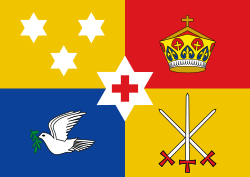- Flag of the Tonga Defence Services
- Customs Service Ensign
- Quarantine Ensign
- Pilot flag, which is similar to the Polish flag
 | |
| Use | Civil and state flag, civil and state ensign |
|---|---|
| Proportion | 1:2 |
| Adopted | 4 November 1875 |
| Design | A red field with the white rectangle on the upper hoist-side corner bearing the red Greek Cross in the centre. |
| Designed by | Shirley Waldemar Baker |
| Naval Ensign of Tonga | |
 | |
| Use | Naval ensign |
| Proportion | 1:2 |
| Royal Standard of Tonga | |
 | |
| Use | Royal standard |
| Proportion | 39:55 |

The national flag of Tonga consists of a red field with a white canton charged with a red couped cross. Adopted in 1875 after being officially enshrined into the nation's constitution, it has been the flag of the Kingdom of Tonga since that year. The constitution stipulates that the national flag can never be changed.







